

|
Equinox Project | Monday, February 9, 2009 With a pending engine delivery (though I found out later that the shipment was delayed and the engine wouldn't arrive for another couple weeks), and cold, frozen ground in front of the shop, I grabbed an appropriate moment to move my large gantry crane from the other shop bay--a process that is essentially simple, yet takes a fair bit of time and a lot of grunting. In any event, I moved the crane in to Equinox's bay for later availability. Afterwards, I worked on several smaller jobs in a stream of consciousness sort of way, from running in a new length of potable water hose between the tank and the galley area, to preparing several lockers and other parts of the bilge for some paint later in the day, to preparing some of the hardware for installation. Nothing seemed to lead to the completion of any single job, yet all were unavoidable small steps in myriad directions. Some days, these less tangible chores manage to consume much of the available time. Continuing on in more concrete directions, I installed, in their original (crooked) holes and positions, the two bronze rudder gudgeons on the transom, using new bronze bolts. I was anxious to install the rudder fairly soon (another use for the crane) and this was the first step in that direction. |
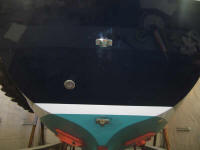
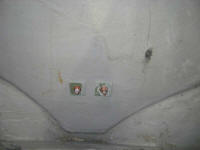 |
|
From prefab fiberglass stock, I made additional backing plates for the stern pulpit bases and stern cleat, which I'd not installed during last week's hardware sessions, and then glued them in place in their respective locations so they'd be ready when I was ready to install the hardware. Later, I painted the inside of the galley sink locker, the battery locker in the bilge, around the water tank on the starboard side, and the after portion of the engine room and beneath the cockpit--this so that this hard-to-access section of the space would be all set when the time came to install the engine and related equipment, though for now I left the main part of the engine room unpainted pending the construction of the new engine foundations. Painting the aft areas now would also allow me to install the stuffing box and lower rudder gudgeon/bolt onto freshly painted surfaces, as well as continue on with the through hulls and their associated plumbing without having to later paint around the new installations. |
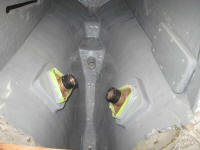
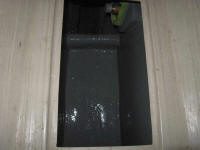
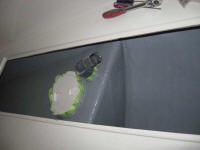 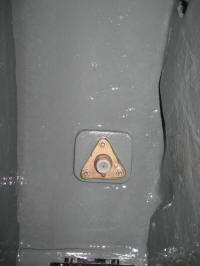 |
|
Finally, I pumped out the diesel tank, which needed to be done partly because the old fuel within might be unreliable for the new engine (in other words, who knew what sort of condition this fuel was in) and partly because I still maintained rose-colored dreams of removing the tank so that I could access certain currently-inaccessible areas within that locker. Measurements earlier had indicated that the tank might, if turned on its side and shifted a bit and with a good bit of luck, fit through the locker opening, though the tolerances seemed so ridiculously tight that I had extremely low confidence. Even though there was a bit of time left in the day, I refrained from attempting to unsecure the tank at this time, with wet paint in the engine room adjacent to the tank area and where one of the straps was secured. To round out the day, I cut over 100 teak bungs that I could use to plug the fastener holes in the caprails and handrails, so they'd be available tomorrow or whenever I got to this task. |
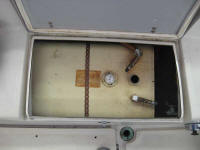 |
|